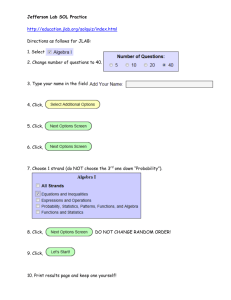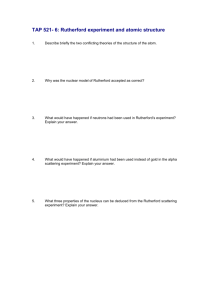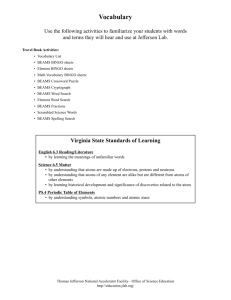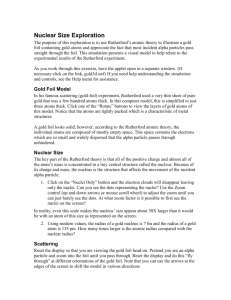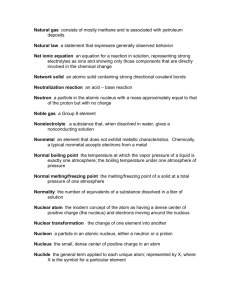The Shape of Things - Science Education at Jefferson Lab
advertisement
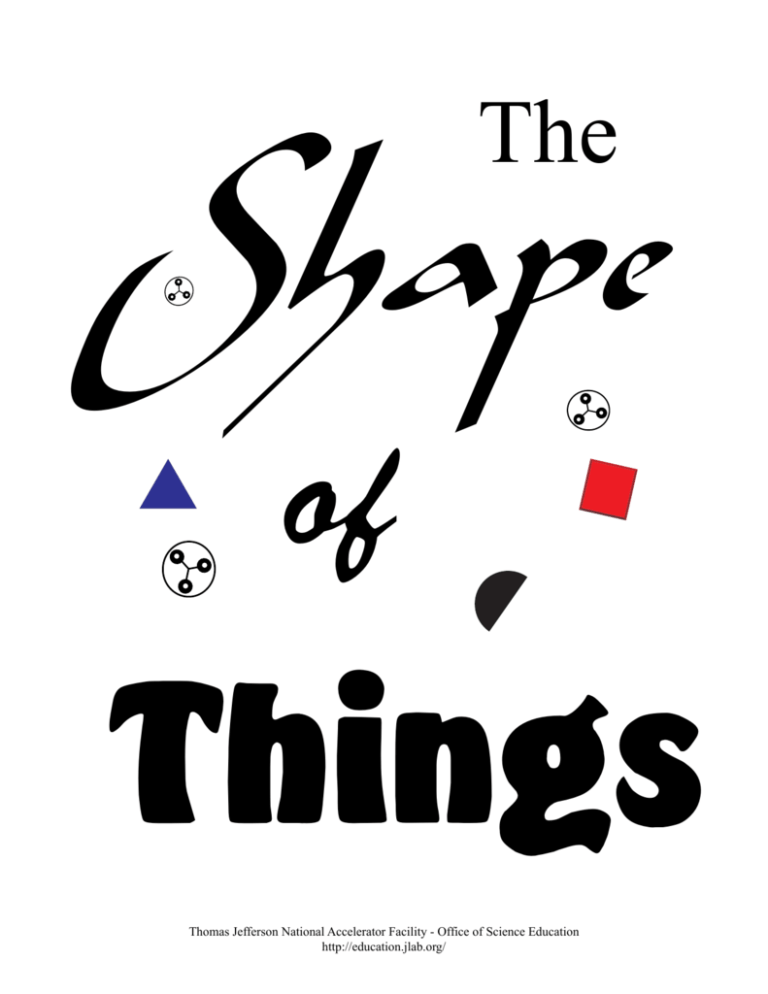
The Shape of Things Thomas Jefferson National Accelerator Facility - Office of Science Education http://education.jlab.org/ The Shape of Things Can you see a hidden shape without using your eyes? 1. To do this experiment, your team will need: • A pie pan with a hidden shape under it (Don’t peek!) • A marble • A plastic ramp 2. It is your team’s mission to discover the shape under the pie pan, but you cannot: • Peek under the pie pan • Feel under the pie pan • Tilt the pie pan 3. Use the plastic ramp to roll the marble under the pie pan. 4. Watch what the marble does. Does it hit something and bounce back out? Does it not hit anything? You can use these clues to discover what is hidden under the pie pan. 5. Keep track of what the marble does by drawing its path on top of the pie pan. Remember, you can’t actually see what the marble is doing, so you will have to estimate what path it took. 6. If the marble looks like it hit something under the pie pan, draw what it could have bounced off of on top of the pie pan. See the example on the next page. 7. Roll the marble under the pie pan many different times from many different directions. 8. Once all of your team members think they know what shape is hidden under the pie pan, call someone over to test you. Don’t turn the pie pan over until your group has been tested! Thomas Jefferson National Accelerator Facility - Office of Science Education http://education.jlab.org/ Where’s the wall? Directions: Look at the path the marble traveled and show the wall the marble hit. Example ll wa his n t le e idd like arb . h e be m y Th to the s wa s i ha ake e th m c to oun b What’s the hIdden shape? Thomas Jefferson National Accelerator Facility - Office of Science Education http://education.jlab.org/ QuestIons to thInk about Directions: Compare the experiment you did in the classroom with the experiments scientists do at Jefferson Lab. What was your...? What is Jefferson Lab's...? energy source accelerator probe unseen target data collector predictor cost time taken for one experiment Thomas Jefferson National Accelerator Facility - Office of Science Education http://education.jlab.org/ Reading About Looking for Quarks Inside the Atom The SHAPE OF THINGS EXPERIMENT shows how SCIENTISTS CAN TEST THEIR THEORIES ABOUT atomS. Directions: Read the following passage. Fill in the blanks with words that make sense. Remember to use context clues that come before and after the blanks. About twenty years ago, three scientists ran some accelerator experiments to study the 1 nucleus at the of the atom. They ran the experiments because they wanted to know 2 . They found that the protons and neutrons in the more about the structure of the 3 nucleus are made of quarks. The discovery of raised new questions about the nucleus. The three scientists are Richard Taylor, Henry Kendall and Jerome Friedman. They did their experiments from 1967 to 1973 in California at the Stanford Linear Accelerator Center, called SLAC for short. These scientists won the 1990 Nobel Prize in Physics, one of the world’s 4 . greatest honors for In the 1960’s some scientists, like Murray Gell-Mann, were beginning to think that each nucleon might really be made up of even smaller particles. Gell-Mann even had a name for the 5 . He called them quarks. smaller Taylor, Kendall and Friedman used beams of high-energy electrons at SLAC to explore deep inside atoms. Inside the two mile long accelerator the electrons gained energy as they moved along in a beam almost as fast as light. At the end of the accelerator, some hydrogen was the 6 into the proton inside of the target for the electrons. Sometimes an electron would hydrogen atoms. These crashes were far too tiny to see directly or even with a microscope. The 7 three experimenters used spectrometers to what happened. Each spectrometer consisted of huge electromagnets, about the of a bus, and some 8 detectors. When electrons crash into a target nucleus, a spectrometer measures their angles and energies as they bounce away. The electrons were not striking solid protons. They were 9 ; each neutron is striking vibrating clusters of quarks. Each proton is a cluster or three too. This new discovery led to new questions. Experiments at Jefferson Lab will answer new 10 about quarks and nuclei. That’s how scientific research works. There is always something new to find out! In fact, that’s why Alfred B. Nobel started the Nobel in 1901. In December, 1990, 11 Taylor, Kendall and Friedman went to Stockholm, Sweden, to receive their Nobel Prize in 12 Physics. The three winners shared not only the honor of the Nobel, but the that comes with it: $710,000. Thomas Jefferson National Accelerator Facility - Office of Science Education http://education.jlab.org/ Directions: Choose the word that fits the context of the passage. 1. a. outside b. edge c. center d. perimeter 2. a. nucleus b. accelerator c. electromagnet d. spectrometer 3. a. alpha b. quarks c. nuclei d. electron 4. a. teachers b. engineers c. farmers d. scientists 5. a. nucleon b. quarks c. particles d. gell 6. a. crash b. glide c. slip d. fall 7. a. wonder b. observe c. question d. argue 8. a. size b. color c. purpose d. strength 9. a. quarks b. bounces c. clusters d. protons 10. a. inventions b. questions c. discoveries d. statements 11. a. medals b. trophies c. prizes d. certificates 12. a. book b. certificate c. paper d. money Thomas Jefferson National Accelerator Facility - Office of Science Education http://education.jlab.org/ Reading About Ernest Rutherford The Shape of Things activity simulates the experiments scientists do in exploring the atom. Directions: Read the passage. Locate the paragraph that contains the answer to each question on the next page. 1. Ernest Rutherford (1871-1937) was digging potatoes in a field in his native country of New Zealand when he got a letter from William Thomson. The letter informed him that he had been accepted as Thomson’s student. What he didn’t know was that he would be making the giant steps towards unraveling the secrets of the atom. 2. As Thomson’s pupil, Rutherford wanted to find some answers to the questions about atomic structure. The best way to learn about the inside of the atom, he decided, was to blow it apart. 3. Rutherford chose the nucleus of the helium atom as the bullet to shoot at the atom. The helium nucleus, which is called an alpha particle, contains two protons and two neutrons. The “gun” to fire the alpha particle was the element radium. Radium is radioactive. It is continually shooting out atomic particles. He placed the radium in a heavy lead container with just a small opening to direct the escaping alpha particles. 4. The target for the alpha particles was a very thin sheet of gold foil, less than 1/100,000 of an inch thick. This is even thinner than the aluminum foil you use to cover food. Yet atoms are so small that the gold foil still had a thickness of more than 2,000 atoms. 5. For his first experiment, he set the foil in front of the radium container. Behind the foil, he placed a fluorescent screen. The screen would show a spark of light whenever it was struck by an alpha particle. Thus, he could see whether any alpha particles were able to pass through the atoms in the gold foil. 6. The actual results were amazing. Rutherford got flashes of light from the screen. Somehow the alpha particles were able to get through. 7. The scientist moved the screen to the sides and even in front, facing the foil. To his amazement he found light flashes at all angles. Some particles were even bouncing off to the side as well as straight back at the radium. 8. In 1911, Rutherford explained what had happened. He suggested that the atom consists of a very small, heavy central core called the nucleus. Very far out from the nucleus are the rapidly swirling electrons. 9. The atom was largely an empty shell. That explained how the alpha particles were able to get through the gold foil. Within the shell, there was a small but heavy nucleus with a positive charge. That is what deflected some of the positive alpha particles and bounced back the few that actually hit the nucleus of the gold atoms. Thomas Jefferson National Accelerator Facility - Office of Science Education http://education.jlab.org/ 10. Rutherford performed another experiment similar to the first to check his picture of the atom. This time he used nitrogen as a target. Most of the particles went straight through the empty space of the nitrogen atoms. A few bumped into the nucleus and bounced off. He also discovered the presence of hydrogen nuclei (more than one nucleus) that had a positive charge. Then he realized that the hydrogen nuclei had to come from within the nitrogen atoms. Rutherford concluded that the atoms of every element contain one or more of these positively charged nuclei. These positive hydrogen nuclei are called protons. 11. On the basis of these results, he set forth a complete model of the atom. The nucleus is made up of heavy, positively charged protons. It has a positive electrical charge. Very far out from this nucleus are the much lighter electrons. Their negative charge balances the positive charge of the nucleus. Directions: Read each question carefully. Locate the paragraph that contains the information needed to answer each question. Write the number of the paragraph on the blank. ______ 1. What is an alpha particle? ______ 2. What was the thickness of the gold foil? ______ 3. What was the target for the alpha particle? ______ 4. How did Rutherford conduct his first experiment to study the inside of an atom? ______ 5. Why did Rutherford put a fluorescent screen behind the foil? ______ 6. What was Rutherford doing when he received an important letter? ______ 7. What happened when Rutherford moved the screen to the side? ______ 8. What did Rutherford discover when he used nitrogen as a target? ______ 9. Why did the nucleus deflect some of the alpha particles? ______ 10. What does the word “nuclei” mean? ______ 11. How did Rutherford check his picture of the atom? ______ 12. What are positive hydrogen nuclei called? Thomas Jefferson National Accelerator Facility - Office of Science Education http://education.jlab.org/ Where’s the wall? Directions: Look at the path the marble traveled and show the wall the marble hit. Example ll wa his n t le e idd like arb . h e be m y Th to the s wa s i ha ake e th m c to oun b What’s the hIdden shape? Thomas Jefferson National Accelerator Facility - Office of Science Education http://education.jlab.org/ QuestIons to thInk about Directions: Compare the experiment you did in the classroom with the experiments scientists do at Jefferson Lab. What was your...? What is Jefferson Lab's...? the student power company plastic ramp the accelerator the marble electrons unseen target wooden shape atoms/quarks data collector round paper computers the student the scientists $5 to $10 $600 million a few minutes a few months energy source accelerator probe predictor cost time taken for one experiment Thomas Jefferson National Accelerator Facility - Office of Science Education http://education.jlab.org/ Reading About Looking for Quarks Inside the Atom The SHAPE OF THINGS EXPERIMENT shows how SCIENTISTS CAN TEST THEIR THEORIES ABOUT atomS. Directions: Read the following passage. Fill in the blanks with words that make sense. Remember to use context clues that come before and after the blanks. About twenty years ago, three scientists ran some accelerator experiments to study the 1 nucleus at the of the atom. They ran the experiments because they wanted to know 2 . They found that the protons and neutrons in the more about the structure of the 3 nucleus are made of quarks. The discovery of raised new questions about the nucleus. The three scientists are Richard Taylor, Henry Kendall and Jerome Friedman. They did their experiments from 1967 to 1973 in California at the Stanford Linear Accelerator Center, called SLAC for short. These scientists won the 1990 Nobel Prize in Physics, one of the world’s 4 . greatest honors for In the 1960’s some scientists, like Murray Gell-Mann, were beginning to think that each nucleon might really be made up of even smaller particles. Gell-Mann even had a name for the 5 . He called them quarks. smaller Taylor, Kendall and Friedman used beams of high-energy electrons at SLAC to explore deep inside atoms. Inside the two mile long accelerator the electrons gained energy as they moved along in a beam almost as fast as light. At the end of the accelerator, some hydrogen was the 6 into the proton inside of the target for the electrons. Sometimes an electron would hydrogen atoms. These crashes were far too tiny to see directly or even with a microscope. The 7 three experimenters used spectrometers to what happened. Each spectrometer consisted of huge electromagnets, about the of a bus, and some 8 detectors. When electrons crash into a target nucleus, a spectrometer measures their angles and energies as they bounce away. The electrons were not striking solid protons. They were 9 ; each neutron is striking vibrating clusters of quarks. Each proton is a cluster or three too. This new discovery led to new questions. Experiments at Jefferson Lab will answer new 10 about quarks and nuclei. That’s how scientific research works. There is always something new to find out! In fact, that’s why Alfred B. Nobel started the Nobel in 1901. In December, 1990, 11 Taylor, Kendall and Friedman went to Stockholm, Sweden, to receive their Nobel Prize in 12 Physics. The three winners shared not only the honor of the Nobel, but the that comes with it: $710,000. Thomas Jefferson National Accelerator Facility - Office of Science Education http://education.jlab.org/ Directions: Choose the word that fits the context of the passage. 1. a. outside b. edge c. center d. perimeter 2. a. nucleus b. accelerator c. electromagnet d. spectrometer 3. a. alpha b. quarks c. nuclei d. electron 4. a. teachers b. engineers c. farmers d. scientists 5. a. nucleon b. quarks c. particles d. gell 6. a. crash b. glide c. slip d. fall 7. a. wonder b. observe c. question d. argue 8. a. size b. color c. purpose d. strength 9. a. quarks b. bounces c. clusters d. protons 10. a. inventions b. questions c. discoveries d. statements 11. a. medals b. trophies c. prizes d. certificates 12. a. book b. certificate c. paper d. money Thomas Jefferson National Accelerator Facility - Office of Science Education http://education.jlab.org/ Reading About Ernest Rutherford The Shape of Things activity simulates the experiments scientists do in exploring the atom. Directions: Read the passage. Locate the paragraph that contains the answer to each question on the next page. 1. Ernest Rutherford (1871-1937) was digging potatoes in a field in his native country of New Zealand when he got a letter from William Thomson. The letter informed him that he had been accepted as Thomson’s student. What he didn’t know was that he would be making the giant steps towards unraveling the secrets of the atom. 2. As Thomson’s pupil, Rutherford wanted to find some answers to the questions about atomic structure. The best way to learn about the inside of the atom, he decided, was to blow it apart. 3. Rutherford chose the nucleus of the helium atom as the bullet to shoot at the atom. The helium nucleus, which is called an alpha particle, contains two protons and two neutrons. The “gun” to fire the alpha particle was the element radium. Radium is radioactive. It is continually shooting out atomic particles. He placed the radium in a heavy lead container with just a small opening to direct the escaping alpha particles. 4. The target for the alpha particles was a very thin sheet of gold foil, less than 1/100,000 of an inch thick. This is even thinner than the aluminum foil you use to cover food. Yet atoms are so small that the gold foil still had a thickness of more than 2,000 atoms. 5. For his first experiment, he set the foil in front of the radium container. Behind the foil, he placed a fluorescent screen. The screen would show a spark of light whenever it was struck by an alpha particle. Thus, he could see whether any alpha particles were able to pass through the atoms in the gold foil. 6. The actual results were amazing. Rutherford got flashes of light from the screen. Somehow the alpha particles were able to get through. 7. The scientist moved the screen to the sides and even in front, facing the foil. To his amazement he found light flashes at all angles. Some particles were even bouncing off to the side as well as straight back at the radium. 8. In 1911, Rutherford explained what had happened. He suggested that the atom consists of a very small, heavy central core called the nucleus. Very far out from the nucleus are the rapidly swirling electrons. 9. The atom was largely an empty shell. That explained how the alpha particles were able to get through the gold foil. Within the shell, there was a small but heavy nucleus with a positive charge. That is what deflected some of the positive alpha particles and bounced back the few that actually hit the nucleus of the gold atoms. Thomas Jefferson National Accelerator Facility - Office of Science Education http://education.jlab.org/ 10. Rutherford performed another experiment similar to the first to check his picture of the atom. This time he used nitrogen as a target. Most of the particles went straight through the empty space of the nitrogen atoms. A few bumped into the nucleus and bounced off. He also discovered the presence of hydrogen nuclei (more than one nucleus) that had a positive charge. Then he realized that the hydrogen nuclei had to come from within the nitrogen atoms. Rutherford concluded that the atoms of every element contain one or more of these positively charged nuclei. These positive hydrogen nuclei are called protons. 11. On the basis of these results, he set forth a complete model of the atom. The nucleus is made up of heavy, positively charged protons. It has a positive electrical charge. Very far out from this nucleus are the much lighter electrons. Their negative charge balances the positive charge of the nucleus. Directions: Read each question carefully. Locate the paragraph that contains the information needed to answer each question. Write the number of the paragraph on the blank. 3 4 2. ______ 4 3. ______ 5 4. ______ 5 5. ______ 1 6. ______ 7 7. ______ 10 8. ______ 9 9. ______ ______ 10 10. ______ 10 11. ______ 10 12. ______ 1. What is an alpha particle? What was the thickness of the gold foil? What was the target for the alpha particle? How did Rutherford conduct his first experiment to study the inside of an atom? Why did Rutherford put a fluorescent screen behind the foil? What was Rutherford doing when he received an important letter? What happened when Rutherford moved the screen to the side? What did Rutherford discover when he used nitrogen as a target? Why did the nucleus deflect some of the alpha particles? What does the word “nuclei” mean? How did Rutherford check his picture of the atom? What are positive hydrogen nuclei called? Thomas Jefferson National Accelerator Facility - Office of Science Education http://education.jlab.org/ The Shape of Things This is an activity in which students determine the shape of a hidden target. Objectives: In this activity students will: • work in groups • roll a marble under a pie pan and observe where it comes out • record the path the marble took under the pie pan on a sheet attached to the top of the pie pan • find the wall the marble bounced off of by constructing a line perpendicular to the path’s bisector • collect additional data by repeatedly rolling the marble under the pie pan • form a hypothesis as to what shape is hidden under the pie pan based on the data collected • prove their hypothesis by predicting the outcome of additional marble rolling experiments Questions to Ask: 1. What was the most difficult part of this experiment? 2. What can you do in your experiment that the scientists at Jefferson Lab can’t? 3. Which was the easiest shape to find? Travel Book Activities: • Reading About Looking for Quarks Inside the Atom • Reading About Ernest Rutherford Thomas Jefferson National Accelerator Facility - Office of Science Education http://education.jlab.org/ Virginia State Standards of Learning English 6.1 Oral Language • by oral participation in small group activities Math 6.14 Geometry • by identifying characteristics of plane shapes Math 6.16 Geometry • by estimating an angle’s bisector in order to create a perpendicular line Science 6.1 Plan and Conduct Investigations • by making observations involving fine discrimination between similar objects • by identifying differences in descriptions and the construction of working definitions • by devising methods to test the validity of inferences • by collecting, recording and analyzing data • by organizing and communicating data through diagrams Science 6.2 Demonstrate Scientific Reasoning and Logic • by basing conclusions on repeated investigations LS.1 Plan and Conduct Investigations • by establishing criteria for evaluating a prediction • by identifying sources of experimental error • by evaluating and defending interpretations from the same set of data PS.1 Plan and Conduct Investigations • by using research methods to investigate practical problems Thomas Jefferson National Accelerator Facility - Office of Science Education http://education.jlab.org/ The Shape of Things Teacher Overview and Materials List Background: No instrument allows the atom’s nucleus to be observed directly, so scientists have to find other ways to learn about it. Scientists at Jefferson Lab use a machine called an electron accelerator to probe atomic nuclei. This accelerator takes electrons, forms them into a beam about the width of a human hair and speeds them up to nearly the speed of light. This fast moving beam of electrons is then directed at a target. Some of the electrons in the beam interact with some of the atoms in the target. When this occurs, the electron changes direction and some particles could fly out of the nucleus. Detectors placed around the target record the paths of the electron and nuclear fragments. These collisions provide scientists with clues about the structure of the nucleus. By bouncing a marble off of a hidden target, students simulate the experiments done at Jefferson Lab. Minimum Materials Needed for Each Student Group: Several wooden shapes hidden underneath pie pans A marble A ramp A pen or marker Data sheets A containment fence Pre-Activity Preparations: The Pie Pans 1. Attach a wooden shape to the inside of a pie pan. When the pie pan is inverted, the wooden shape should be completely hidden from view. 2. Check to make certain that there is enough room for the marble to roll underneath the pie pan. Add some spacer material between the wooden shape and pie pan if necessary. 3. Attach a data sheet to the top of each pie pan. The Ramp 1. Cut a 15 centimeter piece (~6 inch) of PVC pipe in half lengthwise. 2. Use sandpaper to flatten one end of the ramp to help stabilize it. The Containment Fence 1. Cut a one meter length (~3 feet) of garden hose and attach the ends together with a short length of dowel. Notes: • Basic geometric shapes are best for beginners. More elaborate shapes can be constructed for advanced groups. Thomas Jefferson National Accelerator Facility - Office of Science Education http://education.jlab.org/ Materials for The Shape of Things Thomas Jefferson National Accelerator Facility - Office of Science Education http://education.jlab.org/ Four Simple Shapes Attached with Spacer Blocks Thomas Jefferson National Accelerator Facility - Office of Science Education http://education.jlab.org/
